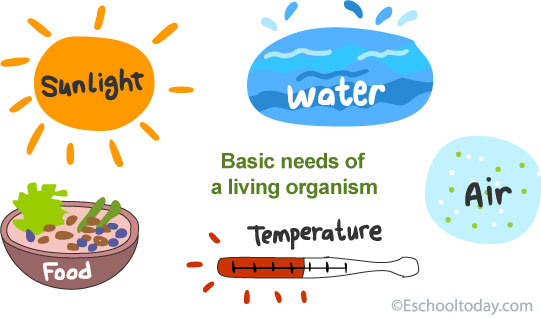- Needs of living things
The basic needs of living things
Every living organism on earth needs some basic things to survive. The amount, way, form, or kind of these needs vary from one organism to another.
For example, water is a basic need for survival. The amount of water a frog needs to survive is not the same as the amount of water a desert cactus plant needs to survive. They all need water, but because they are different living organisms, their water needs will be different, even though they both need water to live.
There are five basic needs that all living things have. They are

Sunlight:
This is probably the most important need for all living organisms because it is the source of all energy. It also provides heat for plants and animals.
Water:
Water is the medium in which living cells and tissue work. Water is also a living environment for many plants and animals.
Air:
Air is made up of several gases, but the two most important gases are Oxygen and Carbon dioxide. Without oxygen, animals will die, and without carbon dioxide, plants cannot survive.
Food (nutrients):
Living things need energy for function. Energy is needed to grow, reproduce, move, and work. Think of what would happen if you stayed for three days without food.
A Habitat with the Right Temperature:
Too cold or too hot? Every living organism needs the ideal temperature to survive either on land or in water.
Certain factors in a living organism’s environment can prevent it from surviving there. Those factors are called ‘limiting factors’. They include soils, temperature, water, sunlight, and physical barriers. Physical barriers may include landforms and water bodies. They often prevent a living organism from moving to another place when conditions get bad in their regular habitat.
Now, we shall take a close look at what each need means and why they must meet their living needs.
